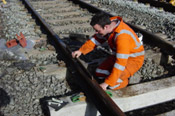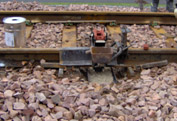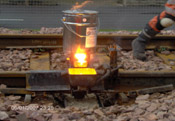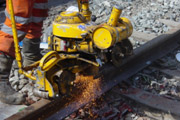Thermit Welding
When applied to the reduction of Iron oxides, the exothermic reaction generates sufficient energy to raise the reaction product temperature to in excess of 3,000°C at which both the metal and aluminium oxide are both liquid:
| Iron Oxide | + | Aluminium | > | Aluminium Oxide | + | Iron | + | Heat |
| 3FeO | + | 2Al | > | Al2O3 | + | 3Fe | + | 880 kJ |
| Fe2O3 | + | 2Al | > | Al2O3 | + | 2Fe | + | 850 kJ |
The process was first used to provide the thermal energy for a method for forge welding rails in 1899, when a number of welded joints were installed in the Essen Tramway. The process was first used in the UK to weld tram rails installed in Leeds in 1904.
Further development leading to the addition of alloying elements to the basic Aluminothermic reaction produced a steel with a compatible metallurgy to the parent rails, thus enabling a full fusion welding process to be developed. While early welds were produced by casting the Thermit steel into hand produced moulds encompassing the two rails to be joined together, subsequent development lead to the introduction of pre formed refractory moulds designed to fit specific rail profiles.
While the basic Aluminothermic process still forms the heart of the Thermit welding processes, continuous development coupled with modern production technology, statistical process control and quality assurance, has resulted in processes which more than match the service demands of modern high speed, high axle load railway systems.
- Conventional “Flat bottom” or “Vignole” Rails
- Special Section Railway rails
- Grooved Tram Rails
- Heavy Section Crane Rails
- Electrical Conductor Rails
In addition, products are available to suit special types of track support, confines spaces, environmental restrictions, and for joining rails of differing types or with differing degrees of wear.
The Process of Thermit Welding
Thermit welding is an effective, highly mobile, method of joining heavy section steel structures such as rails. Essentially a casting process, the high heat input and metallurgical properties of the Thermit steel make the process ideal for welding high strength, high hardness steels such as those used for modern rails.
Thermit Welding is a skilled welding process and must not be undertaken by anyone who has not been trained and certificated to use it.
Detailed operating instructions are provided for each of our processes, but the welding methods all comprise of 6 main elements:
1- A carefully prepared gap must be produced between the two rails, which must then be accurately aligned by means of straightedges to ensure the finished joint is perfectly straight and flat.
2- Pre-formed refractory moulds which are manufactured to accurately fit around the specific rail profile are clamped around the rail gap, and then sealed in position. Equipment for locating the preheating burner, and the Thermit container is then assembled.
3- The weld cavity formed inside the mould is preheated using an oxy fuel gas burner with accurately set gas pressures for a prescribed time. The quality of the finished weld will depend upon the precision of this preheating process.
4- On completion of the preheating, the container is fitted to the top of the moulds, the portion is ignited and the subsequent exothermic reaction produces the molten Thermit Steel. The container incorporates an automatic tapping system enabling the liquid steel – which is at a temperature in excess of 2,500°C – to discharge directly into the weld cavity.
5- The welded joint is allowed to cool for a predetermined time before the excess steel and the mould material is removed from around the top of the rail with the aid of a hydraulic trimming device.
6- When cold the joint is cleaned of all debris, and the rail running surfaces are precision ground the profile. The finished weld must then be inspected before it is passed as ready for service.
Videos:
Source: thermit-welding.com






